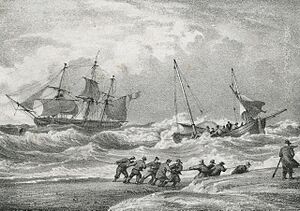Manby mortar facts for kids
The Manby mortar was a special device invented in the early 1800s to save people from shipwrecks. It was like a small cannon that could shoot a rope to a ship stuck near the shore. Once a light rope reached the ship, heavier ropes could be pulled across. These stronger ropes were then used to guide a rescue boat to the ship or to set up a Breeches buoy. A breeches buoy is like a lifebuoy with canvas shorts, allowing a person to be pulled safely to shore.
Captain George William Manby invented this clever device. He got the idea after seeing a ship called HMS Snipe (1801) get stuck near Great Yarmouth in 1807.
The very first time the Manby apparatus was used to save lives was on February 18, 1808. Captain Manby himself led the rescue. Seven sailors were saved from the Plymouth Brig Elizabeth, which was stranded off Great Yarmouth. It's believed that by the time Captain Manby passed away, his invention had helped rescue almost 1,000 people from ships in trouble.
The Manby mortar was used by different groups over the years. These included the Sea Fencibles (a coastal defense force), the Waterguard, and later H M Coastguard. You can even see a Manby Mortar featured on the Hilgay village sign today!
Early Ideas for Ship Rescues
Before Captain Manby, other people had similar ideas for saving shipwrecked sailors, but they weren't as successful. For example, a French inventor named Jacques Joseph Ducarne de Blangy had tried something similar.
In Britain, a soldier named Sergeant John Bell also came up with a way to get a line from a ship to shore in 1792. He even received a reward for his idea. Later, in 1807, more details about his device were shared.
Another person, George Miller (bookseller), had suggested buying a mortar and line to help people from wrecked ships near Dunbar as early as 1793. Miller also helped buy one of Britain's first lifeboats for Dunbar. These earlier attempts show that many people were trying to find ways to save lives at sea, but Manby's design became the most widely used for a time.
How the Manby Mortar Improved
At first, there were some challenges with the Manby mortar. Sometimes the chain would break, or the rope would burn when the mortar fired. Later, Captain Manby praised Captain Harris RN for providing a much better rope. This new rope was lighter, more flexible, stronger, and lasted longer. It was tested in 1838 and worked much better.
For rescues to be successful, both the team on shore operating the mortar and the crew on the distressed ship needed to know what to do. Sadly, even in 1844, some ships were lost because their crews didn't understand how to use the rescue equipment.
In the United States, the Manby mortar had a limited range. In the second half of the 1800s, a new device called the Lyle gun was developed to shoot lines even further.
Eventually, rockets began to replace the Manby mortar for ship rescues. Rockets could often shoot lines further and more accurately. For example, as early as 1842, the crew of the Huzza was rescued off Hartlepool using a rocket.
In 1967, a documentary film was made about Captain Manby and his invention. It showed how the mortar, rockets, and the breeches buoy were used. You can find this film on the East Anglian Film Archive website.
See also
- Breeches buoy
- John Dennett



